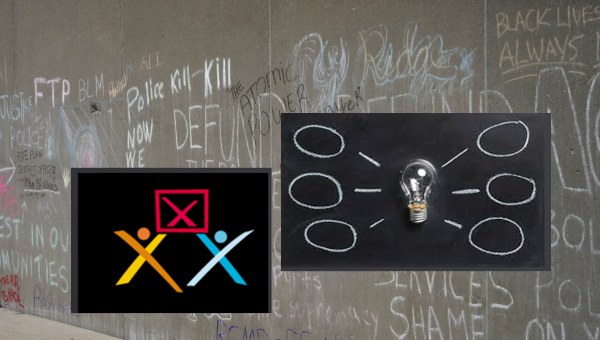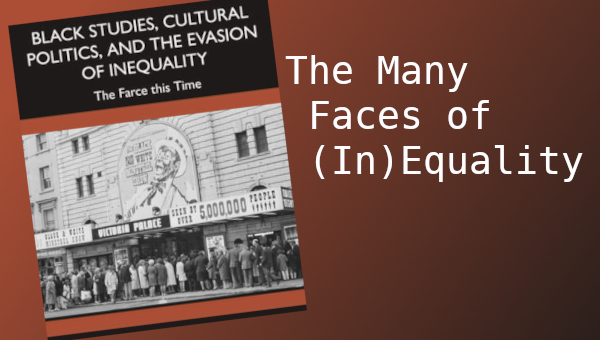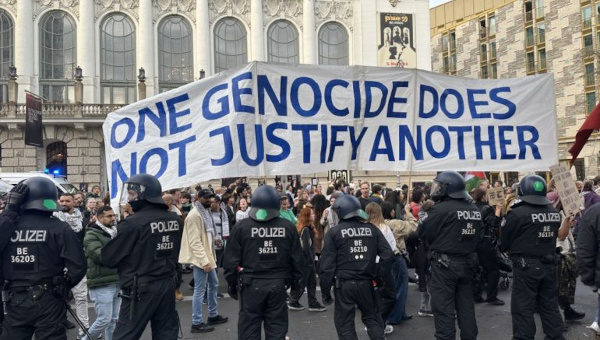Next Steps in the Anti-Racist Struggle?
We have the good fortune to be living in one of those moments when we have a chance to accelerate history. The uncertainty is whether we can actually make it happen.
The culture of protest that has taken such a firm hold among the racialized, young people, and women especially, over the last five years has given social movements an unprecedented legitimacy and presence. The solidarity and protest demonstrations in the US, Canada and around the world sparked by the killing of George Floyd on May 25 reflect the depth and breadth of the smoldering underneath. This is fertile soil, especially during a pandemic when the future is a little blurred and the path forward is not clear or may even be up for grabs.

The calculus of intersectionality is showing proof that the whole is bigger than the sum of its parts. This time, there is a difference in the air, a sense that the moment has come for a final accounting, that a line has been crossed. The anger must be livid when 54 per cent of polled Americans agree that the burning of a Minneapolis precinct to protest the lynching of George Floyd was “justified.” When is the last time a social issue – albeit one involving a life-and-death matter – brought citizens simultaneously into the streets of 700 American and 60 Canadian cities and towns as it did in early June?
No one yet knows how this story will end. In the era of pandemic, every social issue seems to bare its connective tissue to other social issues. Is it any wonder that young women of colour have emerged as the most articulate voices for change? Or that their mothers, who disproportionately risk their lives working in long-term care (LTC) facilities or hospitals, join their children on demonstrations, demanding personal protective equipment (PPE) and a living wage? Or their fathers, compelled to work in ‘essential industries’, and who, as the demographics now show, have caught the COVID virus at work, march beside them as well?
Making History
History is in the making as we take to the streets and together fill the squares around the world. Young people are carrying the future on their shoulders. They share an awareness, which Swedish activist Greta Thunberg articulates, that a climate crisis of unimaginable dimensions looms in the not-so-distant future. But it’s not only the climate or the virus or the economy or the inhumanity of discrimination that lies in the roadway blocking the future of humanity. It’s a confluence of all of them together, visibly wired into the logic circuits of capitalism.
The people on the marches are the most oppressed victims of this social system, and their youth and militancy augurs well for a not-so-far-off incipient political radicalization. The young male Blacks facing violent cops; the gig workers fired for organizing a union; those incarcerated who constantly live with the spectre of death; the healthcare workers who are infected by COVID by the thousands and dying by the hundreds; women workers, who risk their lives as cleaners, food preparers, and childcare workers. These are the people who swelled the often kilometres-long demonstrations and have come back to the streets over and over to express their solidarity with victims of racist violence and systemic discrimination in every sphere of society.
These semi-spontaneous demonstrations were not organized and led by existing radical groups; nor were the bulk of protesters limited to the rank and file of the Black community. Unprecedented numbers of non-racialized people responded to the protests – signalling an unmistakable awakening to the realization of the harm of pervasive systemic racism. More importantly, this tumultuous expression of anger shows the potential for developing a majoritarian bloc thirsting for action on issues that demand urgent resolution.
As the pandemic rattles the pylons that hold the capitalist edifice up, working people are connecting the dots among the social ills caused by lack of adequate housing, poverty, racism, absence of social health and lack of medical care for the old and vulnerable. Yet capitalist institutions have a great ability to adapt when social pressures become too dangerous. As in the past, the powers-that-be take measures to absorb shocks to their system. The massive Keynesian financial outflow from government coffers, doubtless to be restricted as the COVID virus retreats, has already caused the system to lose many of its main ideological supports – the notion that austerity is unavoidable and necessary, that economic inequality is natural, that the poor are undeserving, that capitalism is rational. Any doubts? Buried on the back pages of newspapers where its impact will be muted, you will find reports that, at the height of the pandemic, 3.7 million gallons of fresh milk were dumped into lagoons and manure pits every day in the US. Not to mention the euthanization of hundreds of thousands of chickens and livestock in a devastated US agricultural sector and the criss-crossing by tractors of beans and cabbage fields, ploughing perfectly ripe vegetables back into the soil.
After all, the integrity of the free market and the maintenance of profit-generating price levels could not permit these food products to be distributed for free to the hungry and those in need. It seems their lives and health are worth less than the profits to be made by artificially tightening the market.
Solidarity Demonstrations Rattle the System
The resistance to the glaring inequities of a social system long past its due date has given rise to a plethora of demands from every sector of the population. Front-line health workers strike for PPE; caregivers seek danger pay and stable full-time jobs so that the soldiers can be sent back to their barracks from the long-term care facilities they have been ordered to report on; Indigenous communities call for the provision of adequate housing, clean water, protective equipment and accessible medical facilities; hundreds of workers refuse unsafe work which governments do little to prevent; work camps in the oil industry in northern Canada continue to operate with thousands of workers flown in and out regularly, thereby spreading the virus to the four corners of Canada and to Indigenous settlements. Solidarity demonstrations against police abuse, sometimes so large their size can’t be accurately estimated, as in Montreal in early June, swept the country and also protested local instances of police violence against Indigenous and Black persons in Nova Scotia, Quebec, Ontario, Alberta and BC.
The tremendous upheaval that these bold acts of resistance signify are reflective of, as verified by recent US polls, a dramatic increase in recognition by the white working class of the perniciousness of racial hatred since the murder of Eric Garner in July 2014 in New York, which gave rise to the Black Lives Matter movement. All of this takes place as COVID-19 leaves racialized minorities twice as likely to die as whites from the virus. COVID-19 strips the capitalist system of its main ideological supports, leaving people questioning the very foundations of a system that kills them because of their poverty, the colour of their skin, the absence of adequate medical care, the failure to prepare for a foreseeable scourge that experts advised government actors was imminent and inevitable. Seldom have so many layers of society from every walk of life and background shown such determined agency to upend the system.
However, there is a growing consensus that incremental social change perspectives are unworkable in Canada and the United States – the system has a million ways to deflect, minimize, absorb, confuse, deter and obfuscate bottom-up movements. Real change requires an established, democratically selected leadership to resist and steer through the morass of false promises, tricks, prevarications and political sleight-of-hand machinations of the professional political class. While there has been a tremendous coming together, there has been little co-ordination among the local spokespeople that have emerged from within these different sectors of struggle. It is not a lack of militancy but a lack of cross-organizational structures that characterizes these new impetuous movements. Yes, we march together, but then, we go back to our schools and colleges, our neighbourhoods, our workplaces, our towns and cities, our communities and our families. We echo each other but maintain a social distance. We support the changes called for by others but have no plan on how that support can be harnessed to focus maximum pressure. We are fragmented except for those ad hoc moments of popular mobilization at the crest of our visibility when neither cops nor curfews nor difficulty in physical distancing can force us apart.
We Have Leaders but not a Leadership
To date, we lack the coherence and unity that can sustain us as the ups and downs of our resistance movements inevitably ebb and flow. The flame of indignation will flicker if it is not constantly tended to. Yes, of course, we have a new generation of inspiring, devoted and dedicated leaders in the US, Canada and elsewhere, but we have no centre. We have no co-ordinated programmatic demands that we can advance so that our aims can have behind them the unified strength and force of the millions who are now awakening to their power. The grassroots nature of the protests and their unexpected burst on the stage of history are only the beginning. There is a path to follow, and a roadmap is needed to achieve our collective goals.
We need to talk and listen to each other. We need to exchange our lived experiences directly and share our deepest concerns with others who face similar or parallel issues. Everyone marching in the streets needs to be heard in their own voice in a transparent process free from political manoeuvres or pressures emanating from undisclosed sources that typically lurk behind the curtains of legislative bodies, shaping the discourse and defining the limits, unprincipled trade-offs and compromises made daily by political actors.
Big Thinking Needed in this Moment of History
The need for a multilogue, a conversation among all constituent participants in these social struggles, is a preliminary step that must be taken to consolidate all the forces in these struggles in support of a common vision and shared demands. The fundamental reset that this moment in history requires from us is too grand and capacious to be achieved by any one group or even by a limited alliance of a few groups. Without all of us coalescing together in a visible expression of mutual and collective support and exchange of opinions, a rare opportunity for transformational change will be lost. An all-inclusive, non-partisan, non-electoral and directly democratic exchange in which every participant is valued and every position is debated is the sine qua non without which the unity of all for each and each for all cannot be attained.
Concomitantly, we need to consolidate a cross-organizational, authoritative leadership that is democratically chosen in a transparent process to plan a series of cascading actions. The larger the number of groups and individuals involved in such a democratic process of debate and discussion, the more likely it is to have even greater broad support and to involve the working class in the pursuit of its decisions.
Democracy has many forms. A Citizens’ Assembly (CA) can be selected by random sortation (a lot or lottery) to represent the population of Canada as a whole that will meet to listen to the testimony of representatives selected to speak on behalf of their own constituencies, unions, communities, organizations and institutions. It could be adjusted to accurately consist, in proportion, of women, racialized groups, youth, Indigenous peoples and population centres. By including all sectors of society in their proportionality, we can ensure that the needs of the majority will trump the privileges of the few. No one will be silenced. Everyone will be encouraged to share their story, as well as their aspirations, visions and goals. Proposals will be made, debated, amended and voted on. Once a decision is made, a united front reflecting the broadest agreement will be pursued, and a leadership will be elected to mandate a plan of action.
The larger the scale of the project, the more authority it will have. Of course, discussions and the articulation of mandates will have to start on a local scale within the participating entities. But the ultimate purpose of such a CA will be to achieve unity in action in a sustained manner after a full public discussion with an accountable and transparently elected coordinating body and a clearly defined mandate. In unity there is strength.
Build Alternatives from Below
Respected Marxist economist Michael Lebowitz addressed the issue in an email sent to the Vancouver Ecosocialists, which discusses supporting a CA and issues a call for a discussion involving all the different groups and forces. He lists the wide variety of deliberative democratic forms that exist.
Lebowitz says, “Any combinations of people (be they neighbourhoods, workers [e.g., councils or assemblies] and ‘citizens’) will be challenged by capital and its representatives (hired or ideological) whenever they appear to threaten capital. That’s class struggle, and it is why socialists should be active in creating such structures and struggling within them and stressing the need to connect. For sure, citizens’ assemblies may appear attractive to many under existing conditions in the absence of anything else (i.e., what is there to lose?); that’s why it is essential to build alternatives from below.”
Vancouver Ecosocialists issued a call this past April: “It is urgent that left and progressive groups in Canada (and elsewhere) start discussing how we can combine our forces and other resources to agitate for working people (unionized or not), First Nations, poor communities, and all progressives to fight for what we want ‘the new normal’ to look like.”
We need to assemble full representation as a country. We need to talk to each other in the spirit of emerging grassroots allies. We need to make important and unifying decisions toward a just transition. And then we need to act. Otherwise, we may end up waiting too many years for another moment of opportunity like this to present itself. •





